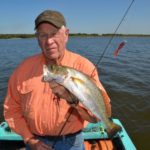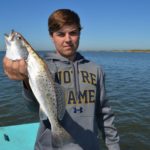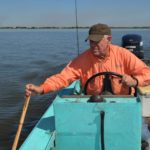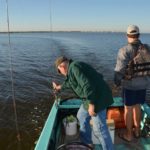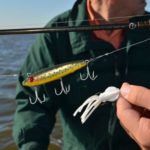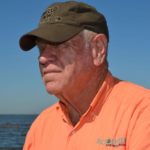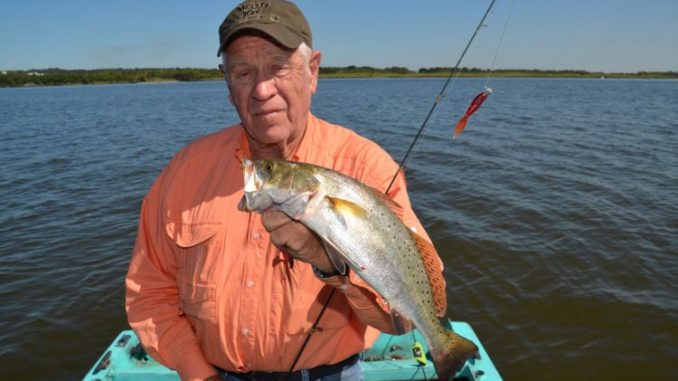
This Cypremort Point angler doesn’t cross his fingers and hope to catch limits of specks. Instead, he trolls until he finds schools, and then he mops up. And that tactic works across the coast.
Like gold, speckled trout are where you find them.
Ahh, but that’s the rub: finding them.
They are aggressive fish — not that hard to catch, but you gotta find them. Like roving wolves, they are mobile, and they are fast.
They don’t hang around long unless there is something for them to eat.
Thousands upon thousands of trout will be in a bay, and 99.9 percent of the bay’s water will be fishless.
Lafayette’s Harold Schoeffler knows the drill well.
“The big thing with trout fishing is finding them,” the 75-year-old Schoeffler said. “Most of the water is unproductive. When you fish a structure, you know the fish are there. But a reef in open water is different. Even if you find the reef, you have to find the fish. A 100-acre reef will have fish on only 1 acre. You have to find that one acre.
“To find that one acre, you can drift and cast, but trolling covers a lot more area. Trolling can seem unproductive while you are doing it, but when you find the fish, it suddenly becomes very productive.”
The winter day of our trip dawned with brilliant blue skies behind a cold front. It was 8 a.m. at the Cypremort Point boat launch into Vermilion Bay.
“I’m not always a crack-of-dawn fisherman,” Schoeffler said. “I fish when the opportunity allows. The weather forecast may be predicting winds 15 to 20 mph. By noon, it may be less than 5.
“I go when I have the opportunity.”
With him was grandson Jean-Paul Schoeffler, one of 11 grandchildren. The 15-year-old attends high school at St. Thomas More Catholic in Lafayette.
The young man is no novice, however; he fishes speckled trout often with his father Todd.
“We started trolling for trout many years ago,” Harold Schoeffler recalled. “At first, we would troll along the beach. I don’t remember when we first used it to locate fish on reefs, but we tried it and it was very effective.”
To his knowledge, the only other people who troll to locate trout are his sons Gordon, Ted, Todd and Harold Jr., along with son-in-law Stephan Comeaux.
“This is pretty much how Dad and I do it in open reef areas, like Ampaw,” Jean-Paul added, using an affectionate nickname for his grandfather. “The only difference is that we use a trolling motor. It is quieter and has less vibration.
Their choice likely has something to do with the fact that they have a larger outboard motor — a 90-horsepower — compared to Harold’s 40-horse.
Of course, Harold doesn’t just begin trolling Vermilion Bay blindly. Like other coastal lakes and bays, Vermilion Bay is a huge place, and a fisherman could troll endlessly through water that seldom, if ever, holds speckled trout very long.
Rather, he concentrates on known areas of good bottom, such as those composed of oyster shells or near where local scuttlebutt says speckled trout are holding.
However, knowing the general area of trout activity isn’t good enough to result in consistently good catches. Harold cited a recent example that took place on Tete Butte, a well-known but not huge oyster reef located just outside Vermilion Bay.
“I drifted over the reef casting and didn’t catch anything,” he said. “I decided to run back to make another drift, but instead of putting my rod up, I set two rods out trolling while I motored back. All of a sudden, both rods bent over with hits.
“I anchored and quickly caught my limit of 25 trout. I wouldn’t have found those fish otherwise. They were off the reef in 6 feet of water.”
With two anglers on the boat, they would be trolling three lines instead of just two. Harold’s setup was remarkable simple.
Each of his two rods were rigged with a single Mann’s Sting Ray Grub — somewhat of a retro bait in today’s crowded soft-plastic field — on a 3/8- or ½-ounce jighead.
Jean-Paul prepared a tandem rig, tying a medium-running lipless MirrOlure directly to his line, followed by 2 feet of monofilament tied to the lure’s rear hook eye. The trailing end of the line was tied to a jighead holding a plastic squid.
The pair set their trolling lines by making extra-long casts, rather than by stripping line off their reels. They inserted the butts of the rods in holders to keep the rod tips vertically so any bite would be instantly noticeable.
Harold trolled at approximately 2 or 3 mph, or as he called it “paddling speed in a canoe.”
He trolled in what he called “meanders,” a loose zigzagging pattern designed to keep the lures working out of the boat’s prop wash most of the time.
“Speckled trout are scared by motor noises,” Harold explained. “It’s really obvious when you use a kayak. You can troll 30 to 40 feet behind a paddled kayak; with a motorboat, you need 40 yards of line out.
“If you troll with a shorter line, you won’t catch much.”
Trolling with no activity was boring, as Harold had cautioned earlier. But when a rod bowed over, lighting hit the air.
Jean-Paul immediately grabbed the bent rod, while Harold threw a marker buoy overboard, disengaged the motor and reeled in the other two lines.
Like much of Harold’s gear, his marker buoys are homemade — but deadly effective. They are simply a 10-foot length of poly rope with a crab trap float tied on one end and a recycled railroad spike on the other.
“The buoy is not in the spot where the fish hit,” he explained. “They are 30 yards farther back. It’s easy to lose your bearings in open water when you are fighting your fish and drifting.
“The buoy provides a precise reference point.”
After Jean-Paul wrestled a nice-sized speck to the boat, his Ampaw circled to where he calculated would be upwind of the spot of the strike.
With the motor off, both men fan-casted to cover the area as they drifted through.
As soon as one of them got a hit, they dropped anchor to work the spot more intensively.
This spot only yielded a couple of fish, so soon they were back to trolling to look for more.
Although Harold stayed alert to his surroundings, it was easy for the passive nature of trolling to lull a passenger into inattention.
But as soon as it did so, a vicious hit on one of the rods seemed to be triggered.
When that happened, everything was action.
Unfortunately, they never trolled into a mother lode of speckled trout, dropping their anchor once and catching their limits in one place.
Their hits on the trolled lures came one at a time, but each spot produced a handful of fish.
“I don’t get too excited when I catch one fish on a trolled lure because it may be a lone ranger, but if two or three rods get a hit, it means that I’m into a big school of fish,” Harold said.
The day went quickly, with never more than a half hour between hook-ups.
The spot on which he focused was somewhat unique because it was a large area of drowned cypress stumps.
“Cypremort” is aptly named, meaning “dead cypress.” In addition to vast areas of oyster beds, northern Cypremort Bay holds seven or eight of these submerged cypress stump areas.
Harold Schoeffler has used his trolling technique all over the state of Louisiana — Grand Isle, the Mermentau area, Coon Point in Terrebonne Parish.
Actually anywhere that holds oyster or shell beds.
“It works excellently on beaches,” Harold said. “There’s really no other way to find trout on beaches unless you see birds working. A lot of people fish beaches by anchoring and casting; you have to be really lucky to land on a pile of fish.
“This works for redfish, too.”
